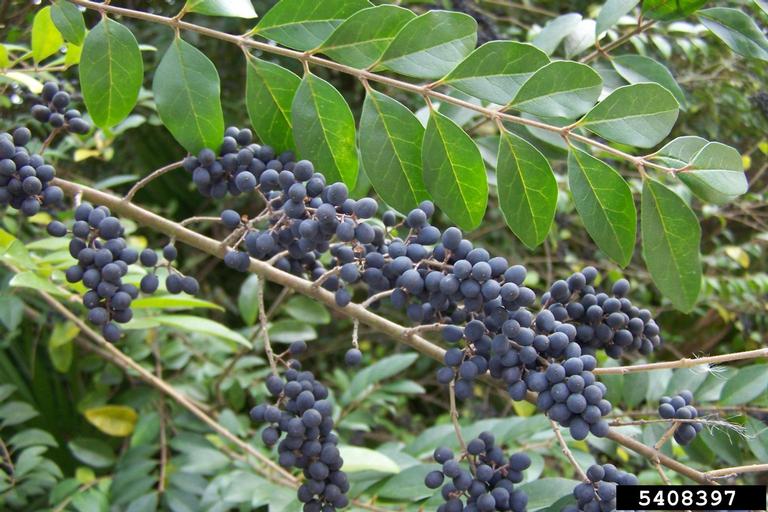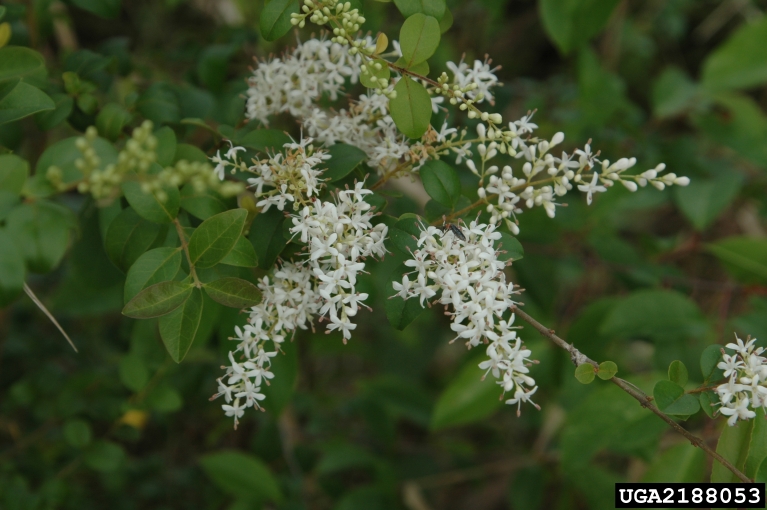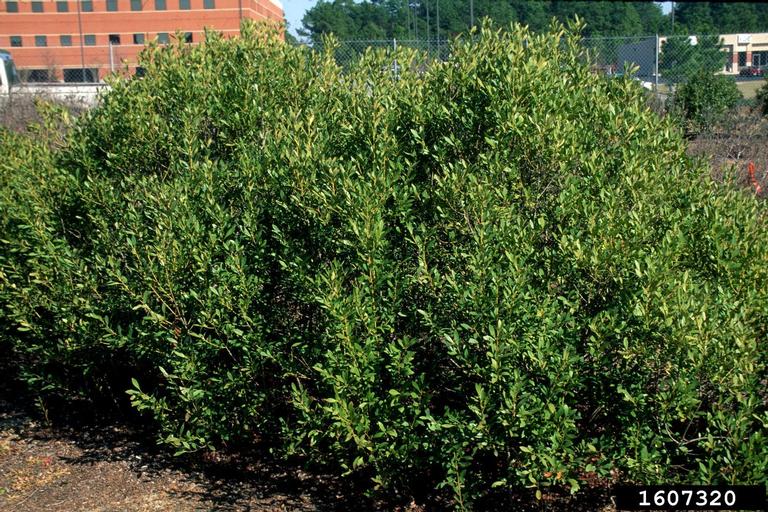Plants in the genus, Ligustrum, commonly called privet, are well-known ornamental plants in the southern garden. The ‘Sunshine’ cultivar has been bred for its golden-yellow foliage and tolerance to a variety of soil conditions and sunlight. ‘Swift Creek’ is known for its variegated, green-and-cream leaves. However, the original privet species that was used to breed these cultivars did not evolve alongside our native plant and animal communities. Native to Europe and Asia, Ligustrum sinense, also known as small-leaf privet or Chinese privet, was brought to the United States in the 1850s as an ornamental plant.
Since then, small-leaf privet has spread rapidly through yards and gardens and into natural areas across the southeastern and mid-Atlantic U.S. Now listed as a Category I invasive species by the Georgia Exotic Plant Pest Council, small-leaf privet has become a major threat to our locally evolved plants and animals.
Small-leaf privet is a shrub or small tree that grows rapidly into dense thickets. For the last century and a half, this feature has been attractive to ornamental gardeners who were looking for privacy shrubs and hedgerows that would fill in quickly. But small-leaf privet has boundary issues and a way of escaping. Their small, abundant fruits entice birds and other wildlife, who eat the berries and disperse the seeds in their droppings. The roots of small-leaf privet also sprout new plants as they grow outwards, creating thick monocultures of this intrusive shrub.

Small-leaf privet is an adaptable species and can tolerate a wide range of soil types, climates, and amounts of sunlight. It’s even resistant to one of our most notorious plant adversaries, deer. As small-leaf privet spreads throughout our natural areas, it shades out native plants, uses up resources, and prevents new trees from establishing. Because of its pioneering nature, small-leaf privet is a common sight in open and disturbed areas, such as roadsides, fence rows, and forest edges. With a tolerance for shade, it thrives in forest interiors, too.
Small-leaf privet can grow up to 20 feet tall, with multiple trunks and long branches. Leaves grow in an opposite (parallel) pattern along stems, with smooth margins and a little fuzz on the underside. Being a semi-evergreen plant, it keeps its leaves throughout the winter but will drop some before spring. Clusters of small, white flowers emerge in late spring and summer, which develop into waxy, deep purple berries that hang around through the winter. Because Ligustrum have been bred as ornamental plants for centuries, multiple species and cultivars exist and are still planted widely. Identifying small-leaf privet may be difficult and should be done with diligence.


So, what can be done? Prevention is the first step: avoid planting Ligustrum sinense cultivars in your landscape! There are plenty of locally adapted alternatives to privet, such as inkberry (Ilex glabra), blackhaw (Viburnum prunifolium), and Carolina cherry laurel (Prunus carolinana). Check out resources from UGA Extension or the Georgia Native Plant Society for more native plant options for your landscape.
Mechanical removal by mowing, cutting, or pulling by hand is possible when plants are small and tender. An attentive gardener may be able to spot new stems and control the spread this way. Take care to remove as much of the root system as possible when hand pulling, as new plants can sprout from even small pieces of roots that remain in the soil.


The most effective option for larger plants and thickets is to use herbicides. The Georgia Pest Management Handbook: Home and Garden Edition has the most up-to-date herbicide recommendations for Georgia growers. When applying herbicides to woody plants, cut stump and basal bark treatments pose the lowest risks to non-target plants and animals. A cut stump treatment means that herbicide is painted onto the cut surface of a stump immediately after the plant is cut down. When applied correctly, the herbicide kills the stump and prevents new growth from resprouting. In a basal bark treatment, herbicide is applied only to the base of the tree or shrub. Herbicides formulated for basal bark treatments are mixed with an oil carrier, which allows them to be absorbed directly through bark.
When using any pesticide, always apply according to label directions and rates, and be sure to wear personal protective equipment as listed on the label.
As plant-inclined people, we can garden thoughtfully to protect and preserve our forests and green spaces. Awareness of introduced species and the impacts they have on our local ecosystems is the first step. From there, we can make informed and impactful gardening choices.
If you have questions about small-leaf privet or other introduced species, contact your local county Extension office.
Learn More
- Ligustrum sinense Fact Sheet (Invasive.org)
- Top Twelve Nonnative Invasive Plants (Georgia Forestry Commission)
- Native Alternatives to Invasive Plants
About the Author

This week’s columnist is Gabrielle LaTora, Agriculture and Natural Resources Agent for UGA Extension Fulton County. An entomologist by training, Gabrielle is interested in insects on farms and in gardens and is passionate about closing the gap between people and their food. In addition to helping coordinate Fulton’s Master Gardener Extension Volunteer program, Gabrielle oversees the North Fulton Community Garden, answers clients’ questions about gardening and natural resources, works with urban farmers, and delivers educational programs for Fulton County residents.